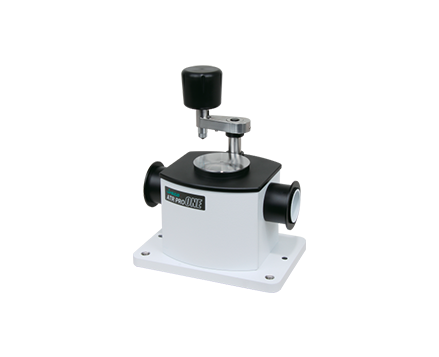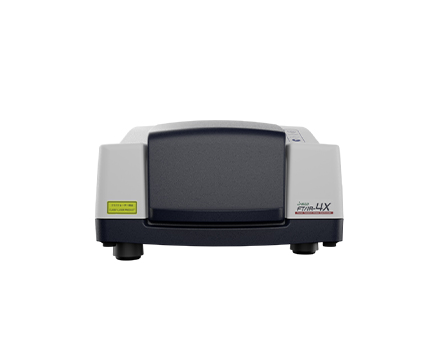FTIR Analysis of Si Wafer Surface Using a 65-Degree Incident Angle ATR
January 4, 2024
Introduction
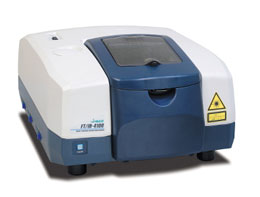
FTIR analysis of silicon wafer or other Si substrates is useful to evaluate the surface or contamination of thermally oxidized films that function as an insulating films for the semiconductors. For surface analysis, techniques such as XPS (X-ray photoelectron spectroscopy, ESCA) and SIMS (secondary ion mass spectrometry) are commonly used, and these provide elemental information about the sample surfaces. On the other hand, infrared spectroscopy (IR) easily provides information on the molecular bonding condition, which cannot be analyzed by XPS or SIMS in a non-destructive manner. For surface analysis using mid-IR, ATR is typically used. However using the 45-degree ATR (the most common configuration), measurement of Si wafers with high refractive index is difficult, as this configuration does not satisfy the total reflection requirements for ATR measurement. With the single-reflection 65-degree incident ATR recently developed (Figure 1), a Ge crystal prism with a high refractive index (n = 4.0) is used, and the incident angle set at 65 degrees, thereby obtaining information on the topmost surface and providing measurements of samples with a high refractive index, such as Si (refractive index=approx. 3.4) and carbon black filled rubbers the refractive index of which can be 2.8 or greater. (See Table 1: FT/IR application data 280-AT-0003)
| Incident Angle | Prism | Lower Measurement Limit at Low Wavenumber Side | n1 | n2 | Penetration Depth (at 1000 cm-1, n=1.5) |
|---|---|---|---|---|---|
| 65º | Ge | - 700 cm-1 | 4.0 | 3.6 | 0.48 μm |
| 45º | Ge | - 700 cm-1 | 4.0 | 2.8 | 0.66 μm |
n1: Refractive index of prism
n2: Upper limit of measurable refractive index of sample (Upper limit that satisfies the total reflection conditions)
Measurements of a natural oxide film on Si wafer surfaces using a single reflection 65- degree incident ATR were made as an application example of the new ATR accessory.
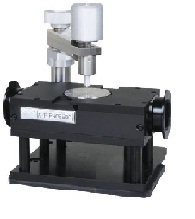
Features of Single Reflection 65-degree Incident ATR (ATR PRO650G)
The ATR PRO650G (Figure 1) features a slip clutch pressure clamp to prevent damage to the sample or prism during application of pressure to ensure proper contact. Furthermore, a large sampling surface is available on the top panel, enabling measurements of the center portion of a sample, such as a six-inch Si wafer. In addition, since an optional polarizer and analyzer can be added to the light path, analysis of the molecular orientation of the sample surface can also be obtained.
Experimental
System: FT/IR-4100 spctrometer
Accessory: ATR PRO650G (Prism: Ge)
Measurement Method: ATR method (Reflection: Single)
Resolution: 4 cm<sup>-1</sup> : Detector: DLATGS
Aperture: 3.5 mm : Accumulations: 128 times
Keywords
220-AT-0222
Results
Measurement was made of a Si wafer surface on which a natural oxide film was present. For comparison purposes, the measurement was made using both a 45-degree incident ATR and transmission. Figure 2 displays the overlaid spectra obtained for the results using the 45-and 65- degree incident ATR accessories, and Figure 3 shows the spectra obtained by normalizing the measurement results of the transmission method and comparing to the spectrum of the 65-degree ATR. From Figure 2, it can be seen that the spectrum of the 45-degree incident ATR does not satisfy the total reflection criteria required for the ATR measurement, and the spectrum presents significant distortion, making it difficult to evaluate the surface condition. The 65-degree incident ATR, satisfies the total refraction requirement, and the spectrum does not present any distortion whilst the base line remains flat. From Figure 3, the absorption peak around 1235 cm-1, attributed to the natural oxide film, is noted, and a slight amount of organic contamination on the surface is present based on the peaks from 3000 to 2800 cm-1, which can be attributed to C-H absorption. Also, the results obtained by the transmission method reveal absorption around 1100 cm-1, which can be attributed to the Si-O in the Si wafer substrate, however, the absorption peak at around 1235 cm-1 cannot be positively determined.
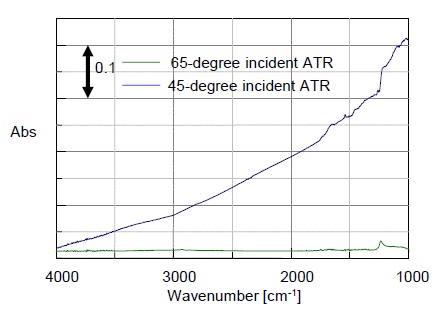
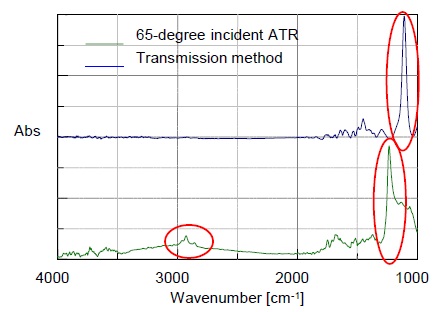
Conclusion
Using the single reflection 65-degree incident ATR enables evaluation of the surface condition of substrates such as Si wafers with a high refractive index in a nondestructive manner. In the future, applications for the qualitative and quantitative evaluation of the adhesion of organic substances onto the surface of Si wafers will be evaluated. The quantitative evaluation of oxide films based on the peak height and area around 1235 cm-1 and the estimation of SiO and SiO2 percentages in the oxide film will be examined.
Featured Products:

FTIR Analysis of Si Wafer Surface Using a 65-Degree Incident Angle ATR
Introduction

FTIR analysis of silicon wafer or other Si substrates is useful to evaluate the surface or contamination of thermally oxidized films that function as an insulating films for the semiconductors. For surface analysis, techniques such as XPS (X-ray photoelectron spectroscopy, ESCA) and SIMS (secondary ion mass spectrometry) are commonly used, and these provide elemental information about the sample surfaces. On the other hand, infrared spectroscopy (IR) easily provides information on the molecular bonding condition, which cannot be analyzed by XPS or SIMS in a non-destructive manner. For surface analysis using mid-IR, ATR is typically used. However using the 45-degree ATR (the most common configuration), measurement of Si wafers with high refractive index is difficult, as this configuration does not satisfy the total reflection requirements for ATR measurement. With the single-reflection 65-degree incident ATR recently developed (Figure 1), a Ge crystal prism with a high refractive index (n = 4.0) is used, and the incident angle set at 65 degrees, thereby obtaining information on the topmost surface and providing measurements of samples with a high refractive index, such as Si (refractive index=approx. 3.4) and carbon black filled rubbers the refractive index of which can be 2.8 or greater. (See Table 1: FT/IR application data 280-AT-0003)
| Incident Angle | Prism | Lower Measurement Limit at Low Wavenumber Side | n1 | n2 | Penetration Depth (at 1000 cm-1, n=1.5) |
|---|---|---|---|---|---|
| 65º | Ge | - 700 cm-1 | 4.0 | 3.6 | 0.48 μm |
| 45º | Ge | - 700 cm-1 | 4.0 | 2.8 | 0.66 μm |
n1: Refractive index of prism
n2: Upper limit of measurable refractive index of sample (Upper limit that satisfies the total reflection conditions)
Measurements of a natural oxide film on Si wafer surfaces using a single reflection 65- degree incident ATR were made as an application example of the new ATR accessory.

Features of Single Reflection 65-degree Incident ATR (ATR PRO650G)
The ATR PRO650G (Figure 1) features a slip clutch pressure clamp to prevent damage to the sample or prism during application of pressure to ensure proper contact. Furthermore, a large sampling surface is available on the top panel, enabling measurements of the center portion of a sample, such as a six-inch Si wafer. In addition, since an optional polarizer and analyzer can be added to the light path, analysis of the molecular orientation of the sample surface can also be obtained.
Experimental
System: FT/IR-4100 spctrometer
Accessory: ATR PRO650G (Prism: Ge)
Measurement Method: ATR method (Reflection: Single)
Resolution: 4 cm<sup>-1</sup> : Detector: DLATGS
Aperture: 3.5 mm : Accumulations: 128 times
Keywords
220-AT-0222
Results
Measurement was made of a Si wafer surface on which a natural oxide film was present. For comparison purposes, the measurement was made using both a 45-degree incident ATR and transmission. Figure 2 displays the overlaid spectra obtained for the results using the 45-and 65- degree incident ATR accessories, and Figure 3 shows the spectra obtained by normalizing the measurement results of the transmission method and comparing to the spectrum of the 65-degree ATR. From Figure 2, it can be seen that the spectrum of the 45-degree incident ATR does not satisfy the total reflection criteria required for the ATR measurement, and the spectrum presents significant distortion, making it difficult to evaluate the surface condition. The 65-degree incident ATR, satisfies the total refraction requirement, and the spectrum does not present any distortion whilst the base line remains flat. From Figure 3, the absorption peak around 1235 cm-1, attributed to the natural oxide film, is noted, and a slight amount of organic contamination on the surface is present based on the peaks from 3000 to 2800 cm-1, which can be attributed to C-H absorption. Also, the results obtained by the transmission method reveal absorption around 1100 cm-1, which can be attributed to the Si-O in the Si wafer substrate, however, the absorption peak at around 1235 cm-1 cannot be positively determined.


Conclusion
Using the single reflection 65-degree incident ATR enables evaluation of the surface condition of substrates such as Si wafers with a high refractive index in a nondestructive manner. In the future, applications for the qualitative and quantitative evaluation of the adhesion of organic substances onto the surface of Si wafers will be evaluated. The quantitative evaluation of oxide films based on the peak height and area around 1235 cm-1 and the estimation of SiO and SiO2 percentages in the oxide film will be examined.

 Download This Application
Download This Application